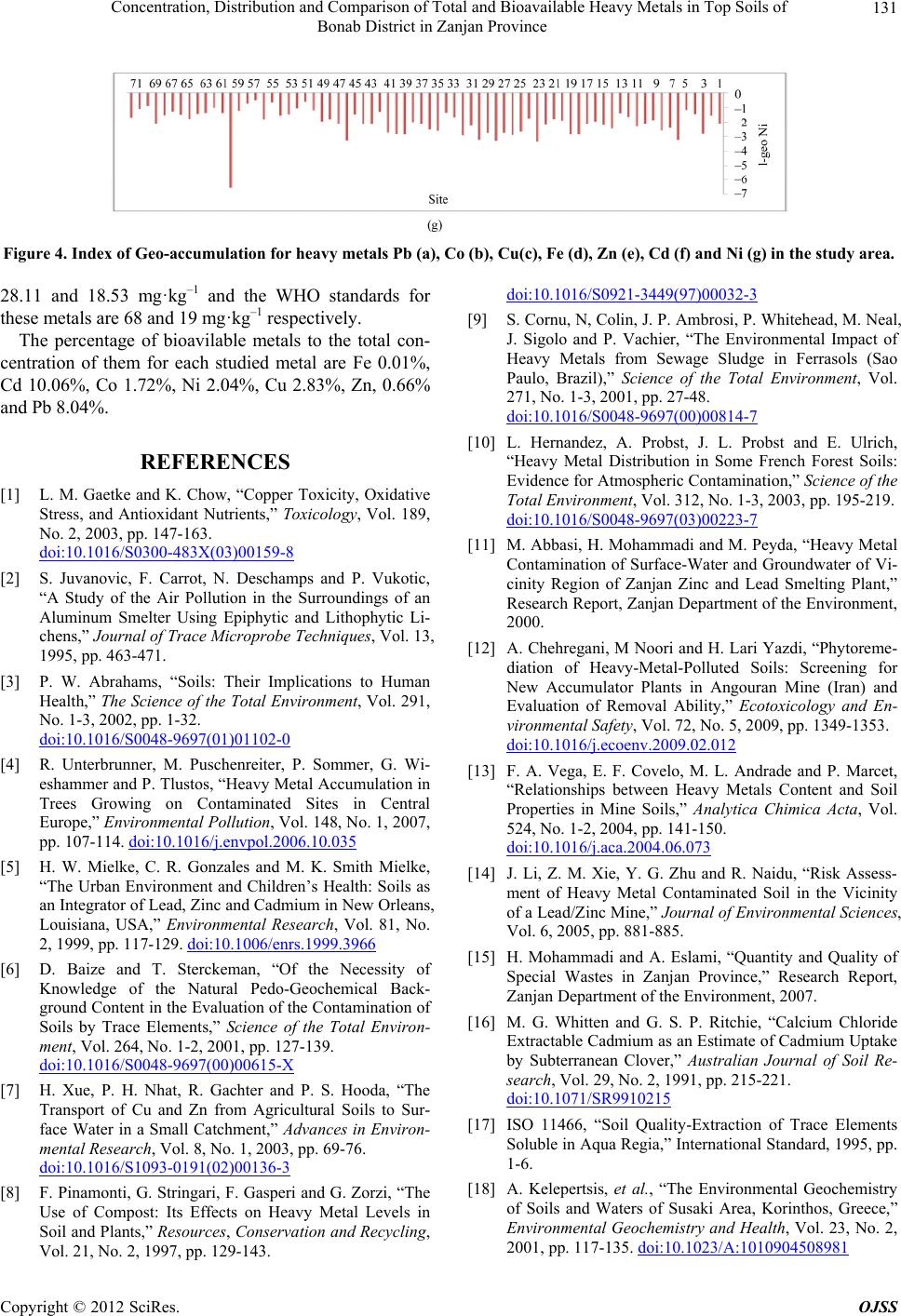
Concentration, Distribution and Comparison of Total and Bioavailable Heavy Metals in Top Soils of
Bonab District in Zanjan Province
Copyright © 2012 SciRes. OJSS
131
Figure 4. Index of Geo-accumulation for heavy metals Pb (a), Co (b), Cu(c), Fe (d), Zn (e), Cd (f) and Ni (g) in the study area.
28.11 and 18.53 mg·kg–1 and the WHO standards for
these metals are 68 and 19 mg·kg–1 respectively.
The percentage of bioavilable metals to the total con-
centration of them for each studied metal are Fe 0.01%,
Cd 10.06%, Co 1.72%, Ni 2.04%, Cu 2.83%, Zn, 0.66%
and Pb 8.04%.
REFERENCES
[1] L. M. Gaetke and K. Chow, “Copper Toxicity, Oxidative
Stress, and Antioxidant Nutrients,” Toxicology, Vol. 189,
No. 2, 2003, pp. 147-163.
doi:10.1016/S0300-483X(03)00159-8
[2] S. Juvanovic, F. Carrot, N. Deschamps and P. Vukotic,
“A Study of the Air Pollution in the Surroundings of an
Aluminum Smelter Using Epiphytic and Lithophytic Li-
chens,” Journal of Trace Microprobe Techniques, Vol. 13,
1995, pp. 463-471.
[3] P. W. Abrahams, “Soils: Their Implications to Human
Health,” The Science of the Total Environment, Vol. 291,
No. 1-3, 2002, pp. 1-32.
doi:10.1016/S0048-9697(01)01102-0
[4] R. Unterbrunner, M. Puschenreiter, P. Sommer, G. Wi-
eshammer and P. Tlustos, “Heavy Metal Accumulation in
Trees Growing on Contaminated Sites in Central
Europe,” Environmental Pollution, Vol. 148, No. 1, 2007,
pp. 107-114. doi:10.1016/j.envpol.2006.10.035
[5] H. W. Mielke, C. R. Gonzales and M. K. Smith Mielke,
“The Urban Environment and Children’s Health: Soils as
an Integrator of Lead, Zinc and Cadmium in New Orleans,
Louisiana, USA,” Environmental Research, Vol. 81, No.
2, 1999, pp. 117-129. doi:10.1006/enrs.1999.3966
[6] D. Baize and T. Sterckeman, “Of the Necessity of
Knowledge of the Natural Pedo-Geochemical Back-
ground Content in the Evaluation of the Contamination of
Soils by Trace Elements,” Science of the Total Environ-
ment, Vol. 264, No. 1-2, 2001, pp. 127-139.
doi:10.1016/S0048-9697(00)00615-X
[7] H. Xue, P. H. Nhat, R. Gachter and P. S. Hooda, “The
Transport of Cu and Zn from Agricultural Soils to Sur-
face Water in a Small Catchment,” Advances in Environ-
mental Research, Vol. 8, No. 1, 2003, pp. 69-76.
doi:10.1016/S1093-0191(02)00136-3
[8] F. Pinamonti, G. Stringari, F. Gasperi and G. Zorzi, “The
Use of Compost: Its Effects on Heavy Metal Levels in
Soil and Plants,” Resources, Conservation and Recycling,
Vol. 21, No. 2, 1997, pp. 129-143.
doi:10.1016/S0921-3449(97)00032-3
[9] S. Cornu, N, Colin, J. P. Ambrosi, P. Whitehead, M. Neal,
J. Sigolo and P. Vachier, “The Environmental Impact of
Heavy Metals from Sewage Sludge in Ferrasols (Sao
Paulo, Brazil),” Science of the Total Environment, Vol.
271, No. 1-3, 2001, pp. 27-48.
doi:10.1016/S0048-9697(00)00814-7
[10] L. Hernandez, A. Probst, J. L. Probst and E. Ulrich,
“Heavy Metal Distribution in Some French Forest Soils:
Evidence for Atmospheric Contamination,” Science of the
Total Environment, Vol. 312, No. 1-3, 2003, pp. 195-219.
doi:10.1016/S0048-9697(03)00223-7
[11] M. Abbasi, H. Mohammadi and M. Peyda, “Heavy Metal
Contamination of Surface-Water and Groundwater of Vi-
cinity Region of Zanjan Zinc and Lead Smelting Plant,”
Research Report, Zanjan Department of the Environment,
2000.
[12] A. Chehregani, M Noori and H. Lari Yazdi, “Phytoreme-
diation of Heavy-Metal-Polluted Soils: Screening for
New Accumulator Plants in Angouran Mine (Iran) and
Evaluation of Removal Ability,” Ecotoxicology and En-
vironmental Safety, Vol. 72, No. 5, 2009, pp. 1349-1353.
doi:10.1016/j.ecoenv.2009.02.012
[13] F. A. Vega, E. F. Covelo, M. L. Andrade and P. Marcet,
“Relationships between Heavy Metals Content and Soil
Properties in Mine Soils,” Analytica Chimica Acta, Vol.
524, No. 1-2, 2004, pp. 141-150.
doi:10.1016/j.aca.2004.06.073
[14] J. Li, Z. M. Xie, Y. G. Zhu and R. Naidu, “Risk Assess-
ment of Heavy Metal Contaminated Soil in the Vicinity
of a Lead/Zinc Mine,” Journal of Environmental Sciences,
Vol. 6, 2005, pp. 881-885.
[15] H. Mohammadi and A. Eslami, “Quantity and Quality of
Special Wastes in Zanjan Province,” Research Report,
Zanjan Department of the Environment, 2007.
[16] M. G. Whitten and G. S. P. Ritchie, “Calcium Chloride
Extractable Cadmium as an Estimate of Cadmium Uptake
by Subterranean Clover,” Australian Journal of Soil Re-
search, Vol. 29, No. 2, 1991, pp. 215-221.
doi:10.1071/SR9910215
[17] ISO 11466, “Soil Quality-Extraction of Trace Elements
Soluble in Aqua Regia,” International Standard, 1995, pp.
1-6.
[18] A. Kelepertsis, et al., “The Environmental Geochemistry
of Soils and Waters of Susaki Area, Korinthos, Greece,”
Environmental Geochemistry and Health, Vol. 23, No. 2,
2001, pp. 117-135. doi:10.1023/A:1010904508981